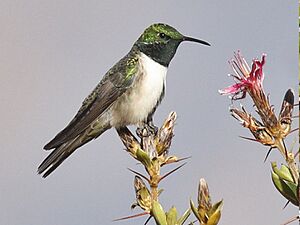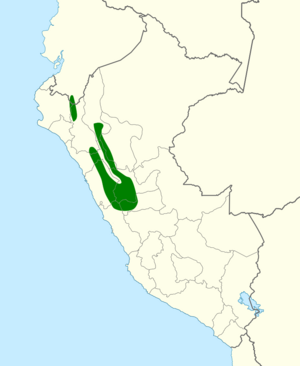Green-headed hillstar facts for kids
Quick facts for kids Green-headed hillstar |
|
|---|---|
 |
|
| Male | |
| Conservation status | |
| Scientific classification | |
| Genus: |
Oreotrochilus
|
| Species: |
stolzmanni
|
 |
|
| Synonyms | |
|
Oreotrochilus estella stolzmanni |
|
The green-headed hillstar (Oreotrochilus stolzmanni) is a type of hummingbird. You can find it in the Andes mountains of southern Ecuador and northern and central Peru. It's one of seven species in the Oreotrochilus group.
This bird gets its name from its shiny bronze and green head. It also has a bright emerald green "gorget," which is like a fancy patch of feathers on its throat. An English bird expert, Osbert Salvin, first found this species in 1895. He named it after a Polish expert, Jean Stanislaus Stolzmann.
Hillstars are special among hummingbirds. They love living in very high places. They have learned many ways to survive the cold weather in the high Andes mountains.
Contents
What Does the Green-Headed Hillstar Look Like?
The green-headed hillstar is a small South American hummingbird. It is about 12 to 13 centimeters (5 inches) long. It weighs around 7.9 to 8.4 grams, which is about the same as two pennies.
Male and female green-headed hillstars look different. This is called sexual dimorphism. Males are much brighter in color.
Male and Female Differences
Males have a shiny bronze-green color on their back, head, and sides. Their wings are dark, almost black or brown, with some green. The middle feathers of their tail are bronze. The outer tail feathers are wide and almost white.
On their front, males have a bright emerald green gorget. This patch can look bronze or blue depending on the light. Their belly is white with a black stripe down the middle.
Female hillstars look similar to males but have different gorget and tail feathers. Their gorget is white with small green or gray spots. Females also have darker tails than males. Their tails are green and black with white edges at the base.
Adult males have slightly larger wings than adult females. Young hillstars look like adult females.
How Green-Headed Hillstars Are Classified
Hummingbirds are part of a bird group called Apodiformes. This group also includes swifts. Within the hummingbird family, Oreotrochilus is a group of hummingbirds. They live in the Andes mountains at very high elevations. These birds can be found from 1,200 to 5,200 meters (3,900 to 17,100 feet) high.
A Separate Species
The green-headed hillstar was first described in 1895. For a long time, people thought it was a type of Andean hillstar. But now, experts mostly agree it's its own separate species. This is because of differences in their genetics and feather colors.
Male green-headed hillstars have a brighter green head. They also have a black line on their belly, not brown, like the Andean hillstar. Studies show the green-headed hillstar is more closely related to the black-breasted hillstar.
In 2019 and 2020, major bird organizations officially made the green-headed hillstar a separate species.
Other Hillstar Species
There are currently seven species in the Oreotrochilus group:
- Green-headed hillstar (Oreotrochilus stolzmanni)
- Andean hillstar (Oreotrochilus estella)
- Ecuadorian hillstar (Oreotrochilus chimborazo)
- Black-breasted hillstar (Oreotrochilus melanogaster)
- Wedge-tailed hillstar (Oreotrochilus adela)
- White-sided hillstar (Oreotrochilus leucopleurus)
- Blue-throated hillstar (Oreotrochilus cyanolaemus)
Scientists believe these different species formed over time. This happened as groups of birds became separated and developed unique traits.
Where Green-Headed Hillstars Live
The green-headed hillstar lives in northern and central Peru. Its home also stretches into the very southern part of the Ecuadorian Andes. They live in rocky, high-altitude grasslands and open areas. You can often find them near Puya and Polylepsis plants.
They usually live at heights of 3,600 to 4,200 meters (11,800 to 13,800 feet). Sometimes, they move to lower areas during certain seasons.
You might spot these birds sitting on rocks or Puya plants. They also land on the ground in open spaces. Female hillstars often stay in valleys with more plants. These areas are good for building nests and raising chicks. Males also use these valleys but spend time in rocky, open areas too.
Green-Headed Hillstar Behavior
Green-headed hillstars are usually seen alone or in pairs. But at night, they gather in groups. They sleep together in cracks and caves on the mountainside. This helps them stay warm on very cold nights. It also protects them from animals that hunt at night.
Like other hummingbirds, green-headed hillstars have a very fast metabolism. This means they burn a lot of energy quickly. So, they need to eat a lot of sugar every day.
To save energy at night, hummingbirds can go into a deep sleep called torpor. This slows down their body functions a lot. Hillstars have special ways to deal with the cold Andes climate. They sleep close together in sheltered spots to keep warm. Also, hummingbirds can hover in the air, but green-headed hillstars rarely do this. Instead, they perch on flowers to drink nectar. They also fly only short distances. These behaviors help them save energy and survive in their cold home.
Vocalization: What Sounds Do They Make?
The green-headed hillstar makes sounds similar to the Andean hillstar. They often make a short, continuous "tsip" or "tseep" sound. They also make melodic chirping sounds. These sounds happen mostly when they are showing off or chasing other hillstars. Both males and females make chase calls.
Scientists have noticed that blue-throated hillstars respond to the green-headed hillstar's calls. Research shows their calls sound very similar.
Green-headed hillstar calls are high-pitched. Hummingbirds communicate and hear sounds between 2 and 5 kilohertz (kHz). Hillstars usually make higher frequency sounds. This might be because they live in high places. It helps their calls stand out from other sounds. They make their highest-pitched calls when sitting on Chuquiraga plants. The green-headed hillstar's calls are estimated to be between 9.9 and 10.7 kHz. Each call lasts about 60 to 122 milliseconds.
The green-headed hillstar's calls are higher than most sounds in their grassland habitat. This means there is little sound competition for them.
Diet: What Do They Eat?
Like other hummingbirds, the green-headed hillstar mainly eats nectar. They prefer nectar and pollen from Puya, Cacti, Chuquiraga, and Cajophora plants. They also sometimes catch flying insects in the air. This is called "hawking."
They usually perch on flowers that are close to the ground. Sometimes, they even rest on the ground. Male hillstars are very protective of their feeding areas.
The green-headed hillstar has a special relationship with the Chuquiraga plant. About 91% of the bird's home range overlaps with where Chuquiraga grows. This plant relies on northern hillstars to help with pollination.
Like most hummingbirds, the green-headed hillstar has a long, thin bill. It also has a long tongue that can stick out. This helps it collect small amounts of nectar from flowers.
Reproduction and Life Cycle
Green-headed hillstars start breeding when they are about two years old. The breeding season usually runs from February to June. Sometimes it continues into August.
The female builds a cup-shaped nest. She uses plant fibers and moss. She places the nest in safe spots. These can be rock cavities, under overhangs, or inside old buildings like barns.
The female lays two white eggs. She sits on them for 19 to 21 days to keep them warm. When the eggs hatch, the chicks are dark. They have two rows of gray fuzzy feathers on their backs. The young birds leave the nest about 36 to 40 days after hatching.
We don't know much about how green-headed hillstars find partners. But males seem to show off their shiny green gorget. They use different body positions and make melodic chirping sounds.
Conservation Status
The green-headed hillstar is listed as a species of "least concern" by the IUCN Red List. This means it is not currently considered endangered. It is common in its large home range across the Peruvian Andes.
Its range is bigger than 20,000 square kilometers. Some experts believe it's actually closer to 108,000 square kilometers.
The total number of adult green-headed hillstars is likely more than 10,000. Their population seems stable. This supports their "least concern" status.
In 2019, about 35% of the green-headed hillstar's home in Peru was in areas with mining permits. However, their rocky habitat is not currently threatened by farming.


